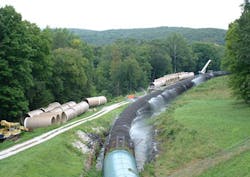A Reliable Restoration
Hydroelectric Power Plant Upgrades Penstock, Improves Costs, Operations
New Milford, Conn., is home to the Rocky River Hydroelectric Power Plant, the first large-scale pumped-storage development in the United States. Declared a National Historic Mechanical Engineering Landmark by the American Society of Mechanical Engineers, the monumental facility recently upgraded its deteriorated penstock.
The original wooden and steel penstock transported water from Candlewood Lake to the Housatonic River by means of the Rocky River facility and vice-versa. Made of Douglas fir that was held in place by iron rings, the 47-year-old penstock was originally built in 1928 and replaced in 1965. As it aged, it began to sag and leak into the drainage ditches that run parallel to the pipeline.
"The wood penstock had clearly outlived its useful life," said Richard Laudenat, hydro plant manager for FirstLight Power Resources, the owner and operator of the Rocky River plant. "To limit the amount of water leakage and extend its useful life, a second set of bands were installed around its circumference, and joints around the pipe were also fitted with wedges. Both of these maintenance activities were to no avail as the wood-stave pipe aged and the sagging continued, which opened it to increased leakage."
The $3 million project was sent for bid in January 2012 and was completed in December 2012. The 15-foot diameter wood-stave penstock was replaced with 10-foot diameter fiberglass pipe. Hobas Pipe USA supplied approximately 950 linear feet of 120-inch piping that included three miter joints of centrifugally-cast, fiberglass-reinforced, polymer mortar (CCFRPM) pipe. It was manufactured with a stiffness class of 36 psi and pressure class of 26 psi, with the line operating under a nominal pressure of 22 pounds per square inch.
The replacement penstock was designed to be reliable, cost-effective and mostly maintenance free. Most of the replacement penstock was half-buried, to the center line, except for two 20-foot sections at the upper end of the penstock. This 40-foot section, supported on concrete cradles, allows for surface water drainage from a hill above the penstock. Further, steel transition sections at the upper and lower end of the new penstock allow for the new 10-foot fiberglass pipe to connect into the existing 15-foot steel sections.
Kleinschmidt Associates, specializing in hydro-generation and water resource projects, was hired to design a replacement pipeline and evaluated three pipe materials for this project: plastic, steel and fiberglass. Hobas was the lowest cost supplier and was awarded the contract after review by the owner. The pipe allows for easy connection into the steel transition pieces, and its hydraulic capacities create more flow within the turbine, ultimately allowing more electricity to be generated due to reduced head losses. As compared with other piping materials, Hobas's pipe exhibits a lower friction factor as well as less head loss in the penstock piping for conduits of the same diameter.
The installation contractor, Blakeslee Arpaia Chapman (BAC), took 11 days to remove the existing wood-stave penstock. "We cut the existing penstock into 20-foot sections, and as these sections were removed, we dropped them onto timbers causing them to implode," explained Joseph DelVecchio, construction superintendent, BAC. They then efficiently installed the new penstock. "Our best production rate was 14 joints in one day. The pipe joined easily, and when honing the pipe, we used less tonnage than was specified for a pipe of that size," he said.
Hobas's FWC coupling joint utilized on this project is a pressure joint. It is commonly used in direct bury applications and also for aboveground installations such as penstocks. It is a structural filament-wound sleeve overwrapped and mechanically-locked to an internal, full-faced elastomeric membrane. The sealing design includes both lip and compression elements so the joint is suitable for both non-pressure and pressure services. The FWC couplings were also supplied with a UV coating that will protect the joints from long-term sun exposure. Fittings were manufactured of the same materials as the pipe, and Hobas provided three mitered elbows: 9, 18 and 20 degrees, which were all encased in concrete to resist deformation.
With the line installed, visual inspection and testing of the joints was performed. "We felt confident in the material, since we have used it previously on other projects, particularly the Jackman Penstock, and are familiar with its performance," explained Harold Thompson, senior consulting engineer, Kleinschmidt. "The FWC coupling proved to be an effective and reliable method to join the sections of Hobas pipe, and everyone was very pleased that no leaks were identified and no joint repairs were required."
"The new penstock continues to meet all of our expectations after its first winter under severe New England weather c," stated Laudenat. "The hydraulic performance of the very smooth interior of the fiberglass pipe allowed for a reduction in the diameter of the pipe. This smaller size reduced the installation project's capital costs and made shipping by truck a much more viable alternative."


